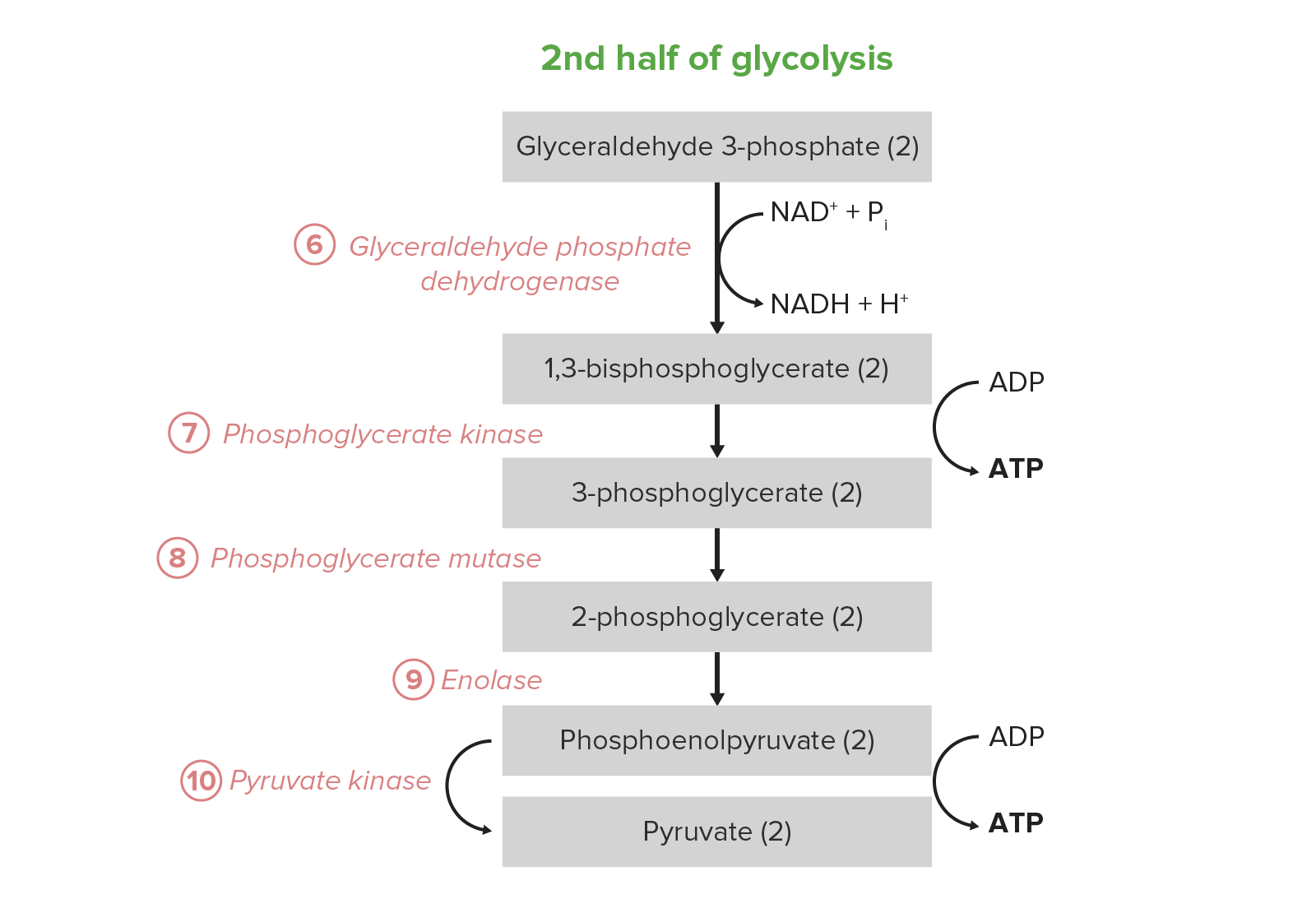Playlist
Show Playlist
Hide Playlist
Glycolysis: F1,6P –> DHAP – Glycolysis and Pyruvate Metabolism
-
04 Advanced CarbohydrateMetabolism.pdf
-
Reference List Biochemistry.pdf
-
Download Lecture Overview
00:02 In the next enzymatic reaction of glycolysis there is something unusual that happens and the cell has to use some tricks in order get passed the barrier. 00:12 What's the barrier? The barrier is shown very clearly on the bottom of this slide. 00:17 The delta G zero prime for this reaction the conversation of fructose-1,6-bisphosphate and the dihydroxyacetone phosphate and glyceraldehyde-3-phosphate The delta G zero prime for this reaction is +23.9kJ/mol. 00:35 Now we remember the delta G zero prime doesn't determine reaction direction but it can effect reaction direction pretty readily. 00:44 That means that this reaction doesn't go very far forward if we start with equal concentrations of everything. 00:51 Well do the cell has to make this reaction go in order to make the glycolysis go, so it uses some tricks. I am gonna show you one the tricks that it uses. 01:01 In reaction catalyze by aldolase that you can see on the top of the screen as I noted there is some tricks that the cell has to use to make this reaction go forwards. 01:10 This energy barrier that you see here is very significant. Now reminding ourselves that the delta G is equal to the delta G zero prime which in this case is 23.9 plus RT times the natural log of all these products on the side. 01:24 We remember that the delta G for a reaction if it's negative will go forwards. 01:29 But if it's positive it will go backwards. So the cells needs to have this delta G overall become negative. 01:36 That means therefore that term on the right, that big mouthful of term, RT times the natural log of all those things in the parenthesis, that term has to be more negative than 23.9 if the reaction is to go forwards. 01:51 Well cells can't violate the rules of nature. I have been saying that many times and it's true. 01:55 So the cell has to play with the rules of nature to make it happened and it does by a very interesting process. The process is called pushing and pulling. 02:04 In pushing a reaction what a cell does is it increases the amount of reactant. 02:09 Well the reactant here is fructose-1,6-bisphosphate and I have drawn the same equation now to indicate and increase in the concentration of fructose-1,6-bisphosphate. 02:21 When this happens that ratio becomes smaller. 02:24 And the smaller that ratio of those all things in the parenthesis becomes, the more negative the natural log will be, and the more negative that overall term will be. 02:36 Well pushing is one trick that cells can use. The other trick that cells use is pulling. 02:41 And the way that cells pull a reaction is by removing products. 02:45 Meaning that the cell can actually take away products that in this case the glyceraldehyde-3-phosphate and dihydroxyacetone phosphate. 02:55 So how does the cell do that? Well as we will see when I talk later in glycolysis, fructose-1,6-bisphosphate has some very interesting affects on another enzyme in glycolysis. 03:08 When fructose-1,6-bisphosphate binds with that enzyme, the reaction ahead of this one start occurring. 03:15 And when they start occurring, all the reactants in front of this one including glyceraldehyde-3-phosphate an dihydroxyacetone phosphate start decreasing. 03:25 We have accomplish pushing and pulling, and by pushing and pulling the cell actually makes the delta G for this reaction to be negative and the reaction goes forward.
About the Lecture
The lecture Glycolysis: F1,6P –> DHAP – Glycolysis and Pyruvate Metabolism by Kevin Ahern, PhD is from the course Carbohydrate Metabolism.
Included Quiz Questions
Which of the following occurs during the aldolase reaction?
- One six-carbon molecule is split into two molecules of three carbons each.
- The reaction is energetically very favorable.
- The reaction can be reversed thanks to pulling and pushing.
- An accumulation of F1,6BP inhibits the enzyme.
- The reaction is pushed forward by the accumulation of glyceraldehyde-3-phosphate.
How does a cell overcome the energy barrier required for the aldolase reaction?
- It overcomes the energy barrier by using the pushing and pulling process.
- It overcomes the energy barrier by using cofactors.
- It overcomes the energy barrier by investing more and more ATPs.
- It overcomes the energy barrier by removing the excess amounts of fructose-1,6-bisphosphate around the enzyme.
- IT overcomes the energy barrier by deactivating the aldolase enzyme.
Customer reviews
5,0 of 5 stars
| 5 Stars |
|
4 |
| 4 Stars |
|
0 |
| 3 Stars |
|
0 |
| 2 Stars |
|
0 |
| 1 Star |
|
0 |
Amazing Dr. Kevin! Thank you very much for this course!
Whenever I get confused about a pathway, I come to watch these videos and it helps tremendously. Thank you for what you do.
He is a very Good Teacher as he teaches as if he was narrating a story.
Love him so far, clear concise and to the point and also very enlightening




